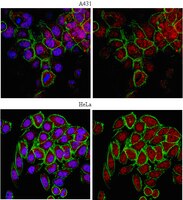ABE64 Sigma-AldrichAnti-ERR-alpha P2 Antibody
Use Anti-ERR-alpha P2 Antibody (Rabbit Polyclonal Antibody) validated in WB, ICC to detect ERR-alpha P2 also known as Estrogen receptor-like 1, Estrogen-related receptor alpha.
More>> Use Anti-ERR-alpha P2 Antibody (Rabbit Polyclonal Antibody) validated in WB, ICC to detect ERR-alpha P2 also known as Estrogen receptor-like 1, Estrogen-related receptor alpha. Less<<Recommended Products
Overview
| Replacement Information |
|---|
Key Spec Table
| Species Reactivity | Key Applications | Host | Format | Antibody Type |
|---|---|---|---|---|
| H, M | WB, ICC | Rb | Purified | Polyclonal Antibody |
| References |
|---|
| Product Information | |
|---|---|
| Format | Purified |
| Control |
|
| Presentation | Purified rabbit polyclonal in buffer containing 0.1 M Tris-Glycine (pH 7.4), 150 mM NaCl with 0.05% sodium azide. |
| Quality Level | MQ100 |
| Physicochemical Information |
|---|
| Dimensions |
|---|
| Materials Information |
|---|
| Toxicological Information |
|---|
| Safety Information according to GHS |
|---|
| Safety Information |
|---|
| Storage and Shipping Information | |
|---|---|
| Storage Conditions | Stable for 1 year at 2-8°C from date of receipt. |
| Packaging Information | |
|---|---|
| Material Size | 100 µg |
| Transport Information |
|---|
| Supplemental Information |
|---|
| Specifications |
|---|
| Global Trade Item Number | |
|---|---|
| Catalogue Number | GTIN |
| ABE64 | 04053252479007 |
Documentation
Anti-ERR-alpha P2 Antibody SDS
| Title |
|---|
Anti-ERR-alpha P2 Antibody Certificates of Analysis
| Title | Lot Number |
|---|---|
| Anti-ERR-alpha - 2451366 | 2451366 |
| Anti-ERR-alpha - 1976935 | 1976935 |
| Anti-ERR-alpha - 3200652 | 3200652 |
| Anti-ERR-alpha - NRG1742826 | NRG1742826 |
| Anti-ERR-alpha Polyclonal Antibody | 2887698 |

















